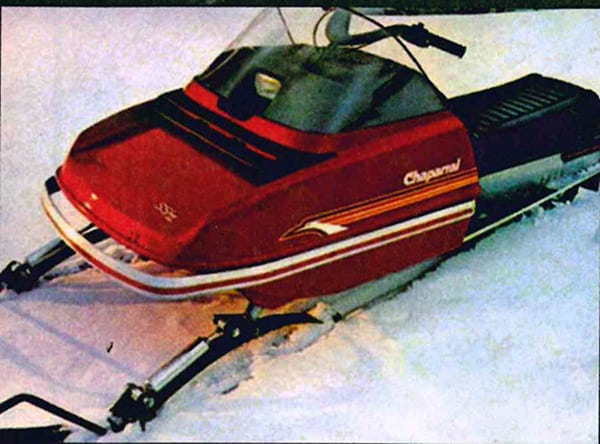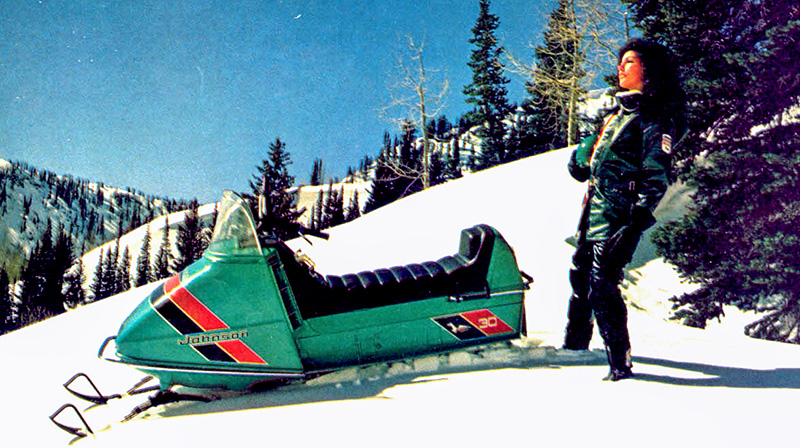
By 1972, Chaparral was on a roll. Armco Steel had acquired Powered Products Corp. and its Snow Birdie snowmobile in 1969. The new owners changed the brand name to Chaparral, which was previously the low-end model in the SnowBirdie line, and poured on the product development dollars.
Chaparral, deemed “America’s fastest growing major snowmobile,” was well on its way to becoming an industry leader when it introduced its 1973 lineup. At the top was a new series of trail performance sleds that evolved from the earlier Firebird SS.
Although saddled with one of the least memorable model names ever – SS/III – its eye-opening performance more than offset its uninspiring nomenclature. Packed with advanced engineering, save the engine inexplicably mounted atop the tunnel, the new candy-apple red sled from Colorado made a big splash.
EDITORS ARE IMPRESSED
Snow Goer riders agreed that “this machine is one of the best,” as our review summarized in a 1973 issue.
“This could be the best of all the ’73s,” declared Invitation To Snowmobiling magazine.
What allowed the SS/III to win this high praise? It started with its lightweight construction, using a riveted aircraft aluminum tunnel with no stirrups, extruded aluminum bumpers and a die-cast aluminum chaincase at a time when most contemporaries were still using formed and welded steel for these parts. The SS/III’s hood and belly pan were formed from Sheet Molding Compound (SMC), the dash panel was high-impact ABS plastic and the molded polyurethane track was unencumbered by heavy steel cleats. This kept the overall dry weight in the range of a claimed 320 to 345 pounds, depending on equipment.
The other side of the performance equation was power. All 1973 Chaparral trail sleds had purposely built axial fan-cooled engines from Fuji Heavy Industries.
The five-port Fuji Heavies with Capacitor Discharge Ignition (CDI) and Teflon-coated piston rings were unusually powerful across the board, including the 45 hp 440 that was the hottest choice for any Chaparral trail sled in 1973.
By contrast, Arctic Cat’s Kawasaki 440 axial fan was only good for about 35 hp, and very few other 440 fans could honestly top 40 hp. One secret to the Fuji’s awesome power was higher compression than other similar engines – at 12:1 it was nearly double some of the competition, including the Kawasaki’s 6.5:1 compression ratio.
My friend Gil purchased an SS/III with the 42 hp 400 engine so he could grass race the sled in the top USSA Stock class of the day. He already owned a 440 Birth-powered 1971 Chaparral Executive wide-track that he liked a lot, but there was no 440 Stock racing class at the time.
A 34 hp 340 was also available in the SS/III. A planned 30 hp 295 model was listed in the first printing of the 1973 Chaparral full-line brochure, but the small-bore model was dropped prior to release. Subsequent brochures publicity made no mention of it.
 The E-Z Rider progressive-rate track suspension was Chaparral’s unique design. Engineered to transfer weight under acceleration and then level off, it featured fully enclosed but adjustable coil-over shock damping units mounted parallel to the ground on each side of the slide rail skid. Pre-drilled holes allowed for the easy addition of up to four sets of wheels for grass drags or marginal snow conditions.
The E-Z Rider progressive-rate track suspension was Chaparral’s unique design. Engineered to transfer weight under acceleration and then level off, it featured fully enclosed but adjustable coil-over shock damping units mounted parallel to the ground on each side of the slide rail skid. Pre-drilled holes allowed for the easy addition of up to four sets of wheels for grass drags or marginal snow conditions.
A Kelsey-Hayes mechanical disc brake provided stopping power, with a hydraulic disc upgrade available. Speedometer, tachometer, handlebar pad, emergency engine kill switch, wrap-around taillight and passenger handgrips were standard, with heat gauge, cigarette lighter, electric start, stirrup kit, chrome skis and 2.25-gallon auxiliary gas tank available as dealer-installed options.
REAL WORLD TESTS
The SS/III would definitely run with the best of its contemporaries, if not flat outrun them. Invitation To Snowmobiling reported that it was the fastest sled it tested that year, beating 13 other machines including a Rupp Nitro 440, a Scorpion Super Stinger 440 and the lighter Alouette 440. However, they didn’t test any of the new free-air stock racers like the Arctic Cat El Tigre or Ski-Doo TNT F/A.
Gil was never really serious about drag racing his 400. He prepped it himself with assistance from several others, including some minimal help from myself, and sporadically entered events with an assortment of riders ranging from Chaparral factory-branch mod racers to his teenage son, John. But the sled was mostly a trail-rider that I got a chance to enjoy every once in a while.
Maybe the most startling trait of the SS/III was its handling. Snow Goer testers uniformly praised its steering, and I can say from personal experience that the sled was phenomenal on twisty trails considering it retained the old-fashioned engine-on-the-tunnel configuration. The high center of gravity gave it only average roll-over resistance despite a relatively wide 28-inch ski stance, but the tight-turning skis and good tracking in just about any snow conditions allowed a smaller turning circle than most contemporaries.
If the SS/III had a shortcoming, it was rider ergonomics. It was a little noisier than the average sled and some riders complained of being bent-over too far while operating it. Personally I never had a problem with either, but I also never rode it all day.
Still, the days of an axial fan machine as a top performance model were numbered. The new free-air stock racers were taking over the track and the trail, and liquid cooling was starting to creep in slowly. Chaparral skipped right over the free-air stage, and discontinued the SS/III after just one season in favor of the liquid-cooled SSX that offered a little more power and refinement, but not quite as good of power-to-weight ratio. This made the 1973 SS/III 440 arguably the hottest Chaparral trail sled ever built.
EPILOGUE
On February 11, 1974, Armco Steel Corporation announced it would immediately liquidate the entire Chaparral line, even though the 1975 line was ready to go. The decision was based on “general conditions,” but everyone knew the 1973 oil embargo played a major role.
More than 40,000 registered Chaparral snowmobile owners were left with orphan machines.
This proud brand, which had pioneered or been an early adopter of many advanced engineering ideas, now pioneered the mass exodus of major manufacturers from the suddenly stone cold snowmobile business.
Editor’s Note: This Flashback article from International Snowmobile Hall of Fame writer David Wells first appeared in Snow Goer magazine. To see more of Wells’ great articles on interesting old sleds, plus in-depth new sled evaluations, aftermarket product tests, informative how-to story, interesting travel features, Snowmobile Science articles and much more, subscribe to Snow Goer magazine.






